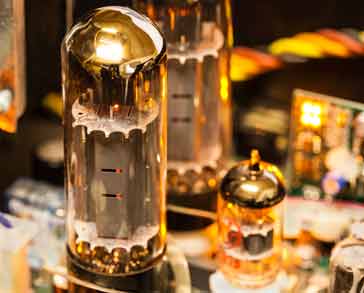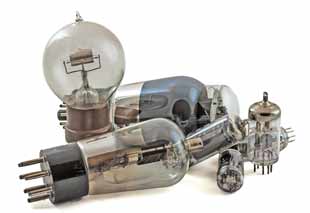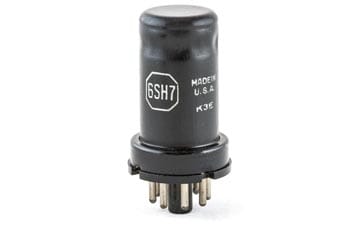What is a Vacuum Tube: Thermionic Valve
Vacuum tube or thermionic valve technology provided the first form of active device used within electronics and they are still used in some specialist applications today.
Vacuum Tube / Thermionic Valves Includes:
Basics
How does a tube work
Vacuum tube electrodes
Diode valve / tube
Triode
Tetrode
Beam Tetrode
Pentode
Equivalents
Pin connections
Numbering systems
Valve sockets / bases
Travelling wave tube
Vacuum tube or thermionic valve technology has been in use since just after the beginning of the twentieth century.
The introduction of thermionic valve or vacuum tube technology enabled the foundations of the electronics industry to be set in place.
Even today, valves, or tubes are used in everything from guitar amplifiers to hi-fi amplifiers and much more.
Many people like the sound produced by these devices and as a result their use has continued in this area as well as many others.

Vacuum tube history
The first observations of what eventually developed into vacuum tube or thermionic valve technology were observed by Edison. In his quest to manufacture better incandescent light bulbs, he noticed and effect that was later called the Edison Effect.
Later Ambrose Fleming used the effect for rectifying radio signals in a new form of radio detector he called his oscillation valve.

The next major development occurred when Lee de Forest added a third electrode called a grid. This opened up the basic thermionic valve or vacuum tube idea to amplify signals and provide considerably more functionality.
Note on Vacuum Tube History:
The first vacuum tube / thermionic valve was developed when Ambrose Fleming used a discovery Edison had made that was called the Edison Effect. Edison had not been able to find any applications for it, but Fleming used this two electrode diode it to rectify radio signals. Later Lee de Forest added a third electrode to make a triode. Further developments improved performance and added additional electrodes.
Read more about Vacuum Tube History
Vacuum tube technology
Vacuum tube or thermionic valve technology is based around the basic concept of thermionic emission.
The concept of thermionic valve or vacuum tubes used the idea that a heated element in a vacuum emitted electrons that would normally remain in the vicinity of this heated element because of the charge attraction.
If a second electrode was placed into the vacuum and a high positive potential placed on it, then the electrons would be attracted away from the heated element towards this element with a high potential. As a result a current would flow in this direction.
As electrons were unable to travel in the reverse direction, this simple valve or vacuum tube acts as a diode.
It is also possible to place a third element known as a grid into the structure between the structure between the other two electrodes. This electrode is normally formed of a gauze to allow electrons to pass through. By varying the potential on this electrode, the flow of electrons can be controlled.

There are a number of electrodes in a valve or vacuum tube:
- Cathode: This is the electrode that is heated and emits the electrons.
- Anode: This electrode in the vacuum tube or valve has a high potential to attract electrons from the cathode.
- Grid: This is the valve electrode that has a variable potential and is used to control the flow of electrons between cathode and anode. In some vacuum tubes more grid are used to improve the performance in various ways.
- Filament: Most valves these days are indirectly heated, i.e. a the filament is not connected to the cathode. The filament heats the cathode which then emits the electrons. Early valves were directly heated and the filament was used to emit the electrons. However this placed limitations on the way in which valves could be used. Having an indirectly heated cathode allows the cathode to operate at a potential higher than ground and also for many filaments to be run in parallel in a single item of equipment.
Vacuum tube types
There are several different types of diode valve. Each has its own properties and can be sued for different applications. Diodes can be used for rectifying, whilst triodes, tetrodes and pentodes are normally used in amplification applications. Heptodes are often used in RF mixers. As a result it is necessary to look at the different types when any application is needed.
- Diode valve : This is the basic form of thermionic valve / vacuum tube device. It consists of a cathode, anode (and of course the heater or filament). Current can only pass through the diode in one way - electrons flowing from the cathode to the anode - in this way it acts as a rectifier or diode.
Read more about . . . . Diode Valve.
- Triode valve: The triode valve has a third electrode added. Called the grid, it is able to control the flow of electrons.
Read more about . . . . Triode Valve.
- Tetrode: The tetrode has an fourth electrode added. Called a screen grid, it is normally held at a high potential but lower than that of the anode.
Read more about . . . . Tetrode Valve.
- Beam tetrode: The beam tetrode valve was an enhancement on the basic tetrode valve. It had special beam plates added to the structure between the screen grid and the anode to beam the electrons towards particular areas on the anode. Also as these plates were held at the same potential as the cathode, electrons striking the anode and bouncing off were returned to the anode, and secondary emission was effectively suppressed.
Read more about . . . . Beam Tetrode Valve.
- Pentode: The pentode had a fifth electrode added. Called the suppressor grid, it was held at a low potential to suppress secondary emission.
Read more about . . . . Pentode Valve.

| Summary of Valve / Tube Types & Numbers of Electrodes | ||
|---|---|---|
| Number of electrodes | Number of grid electrodes | Generic name |
| 3 | 1 | Triode |
| 4 | 2 | Tetrode |
| 5 | 3 | Pentode |
| 6 | 4 | Hexode |
| 7 | 5 | Heptode |
| 8 | 6 | Octode |
The various different types of vacuum tube / thermionic valve enable a variety of different functions to be provided by these devices. Diodes are obviously very different to triodes, etc, but the other types of valve can be used in different circuits as required by the different applications.
More Electronic Components:
Batteries
Capacitors
Connectors
Diodes
FET
Inductors
Memory types
Phototransistor
Quartz crystals
Relays
Resistors
RF connectors
Switches
Surface mount technology
Thyristor
Transformers
Transistor
Unijunction
Valves / Tubes
Return to Components menu . . .



